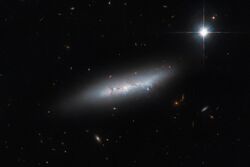Astronomy:NGC 2814
From HandWiki
Short description: Galaxy in the constellation Ursa Major
| NGC 2814 | |
|---|---|
 Hubble Space Telescope image of NGC 2814. | |
| Observation data (J2000 epoch) | |
| Constellation | Ursa Major |
| Right ascension | 09h 21m 11.5s[1] |
| Declination | 64° 15′ 11.5″[1] |
| Redshift | 0.00531[1] |
| Helio radial velocity | 1693 km/s[1] |
| Distance | 82 Mly (25 Mpc)[1] |
| Apparent magnitude (V) | 13.7[1] |
| Characteristics | |
| Type | Sb[1] |
| Size | ~33,400 ly (10.25 kpc) (estimated)[1] |
| Apparent size (V) | 1.1' x 0.3'[1] |
| Other designations | |
| UGC 4952, CGCG 312-3, MCG +11-12-004, PGC 26469[1] | |
NGC 2814 is a small spiral galaxy in the constellation Ursa Major. Its velocity relative to the cosmic microwave background is 1,693 ± 8 km/s, which corresponds to a Hubble distance of 25.0 ± 1.8 Mpc (∼81.5 million light years.).[1] Germany astronomer William Herschel discovered this galaxy on 3 April 1791.
NGC 2814 has a luminosity class of II.[1]
NGC 2814 has three galactic neighbours: the side-on spiral galaxy NGC 2820; the irregular galaxy IC 2458; and the face-on non-barred spiral galaxy NGC 2805. Collectively, the four galaxies make up the galaxy group known as Holmberg 124.[2]
One supernova has been observed in NGC 2814: SN 2020mmz (type II, mag. 17).[3]
See also
References
- ↑ 1.00 1.01 1.02 1.03 1.04 1.05 1.06 1.07 1.08 1.09 1.10 1.11 "NASA/IPAC Extragalactic Database". Results for NGC 2814. http://ned.ipac.caltech.edu/byname?objname=NGC+2814.
- ↑ ESA/Hubble "Late-type" galaxy? Retrieved 19 November 2023.
- ↑ Transient Name Server entry for SN 2020mmz. Retrieved 19 November 2023.
External links
- NGC 2814 on WikiSky: DSS2, SDSS, GALEX, IRAS, Hydrogen α, X-Ray, Astrophoto, Sky Map, Articles and images
 |

